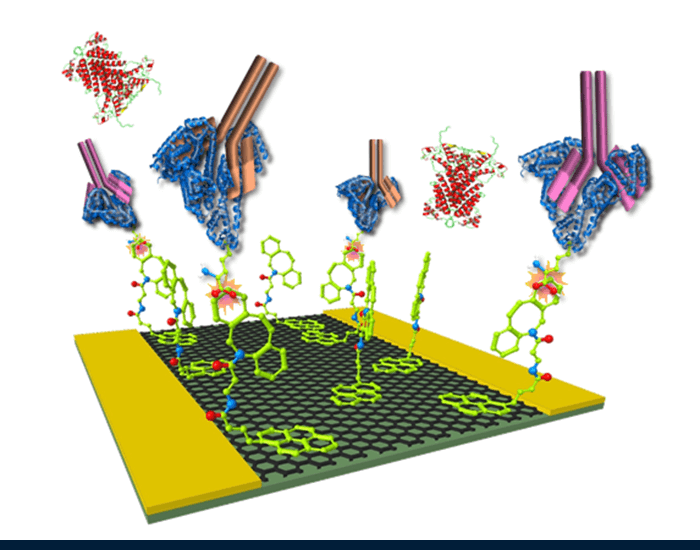The results of a new study published Sept. 17 in Lab on a Chip illustrate the impact of a graphene-based biosensors in identifying the circulating biomarkers of aging.
Keck Graduate Institute (KGI) Assistant Professor Kiana Aran authored the study in collaboration with UC Berkeley Professor Irina Conboy, a pioneer in aging research, and Nanomedical Diagnostics, a start-up company focusing on mass production of graphene-based sensors.
As a way to replace conventional assays, the research team presented a new portable digital device for biosensing based on functionalized graphene that can be employed for any click-able application.
The lab-on-a-chip technology called Click-A+Chip is designed for facile and rapid digital detection of azido-nor-leucine (ANL)-labeled proteomes present in minute amount of sample.

On-chip detection: digital identification of proteins.
Studies of heterochronic parabiosis, where two animals of different ages are joined surgically, provided proof-of-principle results that systemic proteins have broad age-specific effects on tissue health and repair. In an effort to identify these systemic proteins, bio-orthogonal non-canonical amino acid tagging (BONCAT) is used to tag these proteins.
“Although BONCAT is a very powerful technology,” Aran says, “the challenges associated with its complexity including large starting material requirements and cost of ANL-labeled protein detection, such as modified Antibody Arrays and Mass Spectrometry, limit its application.”
Click-A+Chip is a graphene-based field effect biosensor which utilizes novel on-chip click-chemistry to specifically bind to ANL-labeled biomolecules. In this study, Click-A+Chip was utilized for the capture of ANL-labeled proteins transferred from young to old parabiotic mouse partners.
The research team was able to identify the young-derived ANL-labeled Lif-1 and Leptin in parabiotic systemic milieu, confirming previous data as well as providing novel findings on the relative levels of these factors in young versus old parabionts.
The results demonstrated that Click-A+Chip can be used for rapid detection and identification of ANL-labeled proteins, significantly reducing the sample size, complexity, cost, and time associated with BONCAT analysis.
Source: Keck Graduate Institute




